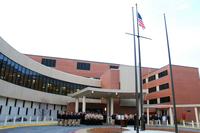The military is taking new ways of fighting, learned on Iraq’s battlefields, to Afghanistan. The new approach combines troops operating in distributed teams on the ground supported by vast numbers of aerial drones, satellites, precision weapons and spies working informants, according to Gen. David Petraeus.
“This is the answer,” the Central Command chief said before an overflow crowd yesterday at the annual CNAS conference in Washington, “This is how we fight, when we can, with all of the assets that we have.” While acknowledging that the rural and mountainous Afghan landscape is very different from Iraq’s concentrated urban battle zones, to counter the “Pashtun insurgency,” the military is trying to replicate the same operational approach that proved highly effective in battling a shadowy enemy in Iraq.
He showed a slide depicting a snap shot of the fighting in Sadr City in April 2008, and contrasted the new way of fighting in that battle with the old way of fighting as exemplified by the 2004 battles in Fallujah. To root out entrenched guerrillas there, Marines and soldiers were forced to fight street-by-street and house-to-house, and in the process, particularly in the case of the Marines, suffered heavy casualties and leveled much of the city.
The Sadr city offensive was very different, using precision firepower and targeted raids based on accurate human and electronic intelligence. In spring 2008, the Mahdi Army and other Shiite militia launched counterattacks in Baghdad in response to the U.S. and Iraqi offensive to root out Shiite militias in the southern city of, Basra. They attacked the Green Zone and other targets around Baghdad, primarily with rockets, from inside Sadr City.
American commanders responded with a high-low mix of special operations and regular troops on the ground conducting targeted raids and aggressive sniping, supported by a fantastic array of electronic eyes overhead, and a network of spies and informants in the shadows. Petraeus listed the assets that supported soldiers, tanks, Bradleys and Strykers in the streets and alleys: 11 UAVs overhead 24 hours a day including armed Predators, 3 each Shadows and Ravens, a special intelligence drone, a SOF drone, satellites, fire-finder radars ringing the city, surveillance blimps, cameras atop towers, SEAL sniper teams and CIA spies. In three weeks, they destroyed 77 rocket teams and took out about 780 militia fighters, Petraeus said.
“We’re shifting these kinds of assets to Afghanistan,” he said, “we’re taking those lessons from Iraq and trying to apply them in Afghanistan.” The focus of the U.S. counteroffensive in Afghanistan is the Pashtun insurgency, Petraeus said, based in Kandahar and Helmand provinces where U.S. troops are now flowing. The newly appointed American commander in Afghanistan, Gen. Stanley McChrystal, will have a much larger force to battle the insurgents than did his predecessor Gen. McKiernan. U.S. troop strength there is rising from the 31,000 troops at the end of last year to what will be nearly 68,000 by the fall.
An additional Combat Aviation Brigade is being sent to Kandahar, which, along with the Marine aircraft, doubles the number of helicopters in Afghanistan; Petraeus said it increases by six-fold the number of helicopters available for combat operations because so many of the helicopters there now are tasked with the medevac mission. The Marine Expeditionary Brigade is going into Helmand province, which is being prepped for their arrival by special operations forces. The Stryker brigade, just now arriving, will go to Kandahar. A brigade from the 82nd, beefed up with additional junior officers and NCOs, will be scattered about to provide advisers for Afghan military and police units, again primarily in the south.
The paratroopers will hopefully help address what Petraeus said is the biggest challenge at the moment: trying to rapidly build the Afghan army. Finding good Afghan division, brigade and battalion commanders along with large numbers of field grades to provide needed field staff is proving particularly difficult. Producing those leaders will take years of experience, education and training, he said.







